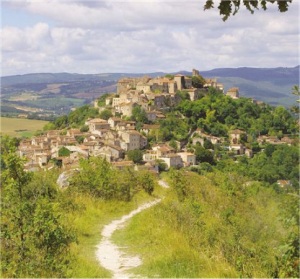The Hautes-Pyrénées department is found in the mountains of the Pyrénées along the  French border with Spain. The department falls within the Midi-Pyrénées region of France.
French border with Spain. The department falls within the Midi-Pyrénées region of France.
It is the mountains and dramatic scenery that hold much of the attraction of the Hautes-Pyrénées, with outdoor sports in the mountain region (from cycling to hiking and rafting) being especially popular. But before rushing southwards, there are some towns that also have great appeal.
Galan
This attractive village, which is about 2 miles from Libaros, was nicknamed “Paradise in Bigorre“. It’s pretty steets and lanes are lined with ancient houses and public buildings ranging in architecture styles from the 1th century to the 2nd Empire in the mid-1800. The oldest house dsates back to 1318. The altarpiece of the small, but majestic cathedral of St Julien is the work of the sculptor Ferrère in the 18th century. The attached tower dates to the 16th century. Near the village is the castle of Montastruc and Notre-Dame of Garaison.
At the far north of the Hautes-Pyrenees department is the market town of Maubourguet. Head south via Vic-en-Bigorre to a popular stop-off point en-route for the mountains is the town of Tarbes. By now you will begin to see stunning views of the mountains. To the south of Tarbes is the town with more hotels than any other city in France except Paris…Lourdes.
LourdesLourdes is of course the famous site of miraculous healing powers and very popular pilgrimage destination that attracts hundreds of thousands of people each year.
Even if you are not in need of the healing powers you might find Lourdes to be an ‘interesting’ place to visit – if you are expecting a quiet Pyreneean town you migh be a bit surprised by what you discover!
South Hautes-Pyrenees
Escaping south from the crowds and commercialisation of Lourdes, you enter the Pyrenees ‘proper’. The first great highlight is the Pic du Midi de Bigorre – visible from many places in the region, and at 2877 metres high offering stunning views across the surrounding mountains. You can ascend to the peak (shared with an observatory) by cable car.
Following the Tour de France Route
Continue south to enjoy the best of the Pyrenees National Park, and even venture to Mont Perdu in the deep Pyrenees on the Spanish border, a listed world heritage site. The Col d’Aspin is just one of several very scenic routes to follow, as is the Aure Valley further east in the department.

‘An artist could paint here for a year, and never repeat himself, and his paintings would all be beautiful.’ T.E.Lawrence (Lawrence of Arabia),writing of Cordes-sur-Ciel.
The Cirque de Gavarnie, an imposing cliff face south of Luz and Argeles, again on the Spanish border, is a good place for hikers to start exploring the region – and an impressive sight in its own right, as well as being one of a small selection of locations designated as Grand Sites of France’.
Skiing in winter, and walking and cycling in summer, make the Pyrenees very much an outdoors destination. Some of the popular ski stations here include Cauterets, Saint-Lary-Soulan, Tourmalet, Luz-Ardiden and Hautacam.
Hautes-Pyrenees is also a magnet for lovers of spa treatments, particularly at Bagneres-de-Bigorre and Cauterets.



Anngab said:
Hey neighbor
I saw you moving around my house. You looks nice ;). Do you would like to meet? See my pictures here:
https://flipme.link/FClOjI
Im living alone, whenever you like.
Tell me if you are into it
– Anna